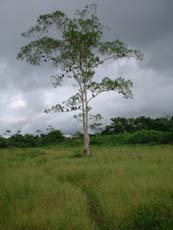
Llanchama, A Parchment From the Rainforest
The Bora people of the Peruvian Amazon
produce a parchment from the inner bark of the llanchama (pronounced john-chama).
This tree, Poulsenia armata, a kind of fig tree, is fairly common and
grows tall and straight in the jungle. The Boras use this parchment as a
surface for painting and as a material for their traditional clothing.
The Boras will travel deep into the jungle, and select a llanchama tree making sure the trunk is uniform. They will then slit the trunk and carefully peel off the bark. Taking the bark back to the village, they wash the material and pound it with wooden pestles until it is thin and pliable. When dried, a good llanchama parchment should be a uniform, off-white, with no large imperfections or stains.
Iíve seen llanchama from handkerchief-size pieces up to a square yard or so in size.
The Boras wrap the llanchama pieces around their waists as their only article of clothing. It looks great on women and ok on men. Itís their traditional dress and they are proud of it.
Typically the Boras decorate their llanchama clothing with geometrical designs reminiscent of North American Indian art. They use a dye from the huito plant, Genipa americana for their ink.
Of course, Boras, with an eye for business, will often draw contemporary jungle scenesóbirds sunsets and the like on their llanchama pieces.
The result is a lot of velvet-Elvis stuff thatís a waste of a good tree. These paintings are usually pawned off as traditional art to unsuspecting tourists in Iquitos.
Street art aside, quality art on llanchama is found in the paintings of Francisco Grippa. His painting sell in salons around the world and fetch world-class prices.
Still though, traditional llanchama clothing with the geometrical designs are fine and worthy of a rainforest collection.
Meanwhile if you have thoughts on llanchama or particular pieces you want me to look for, just drop me a note through my contact page. Be sure to mention llanchama in the subject line.